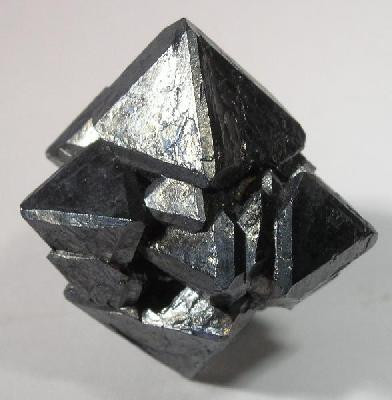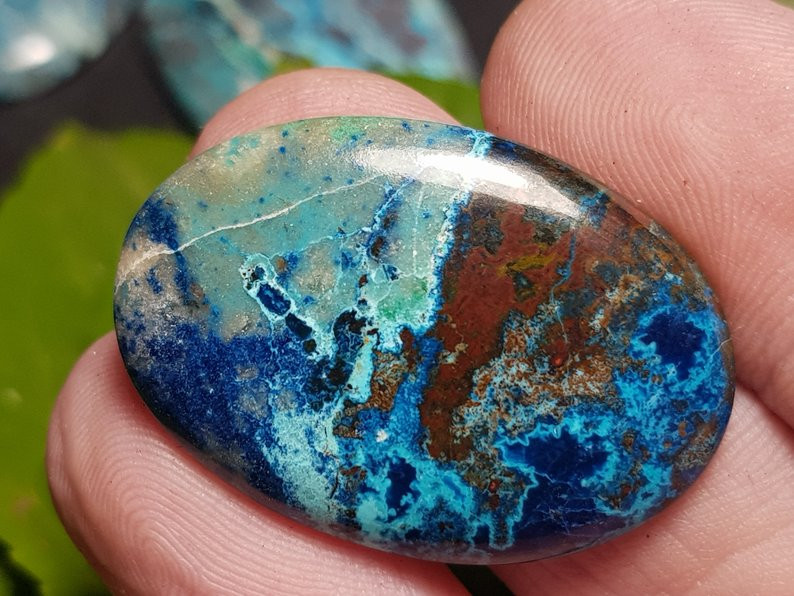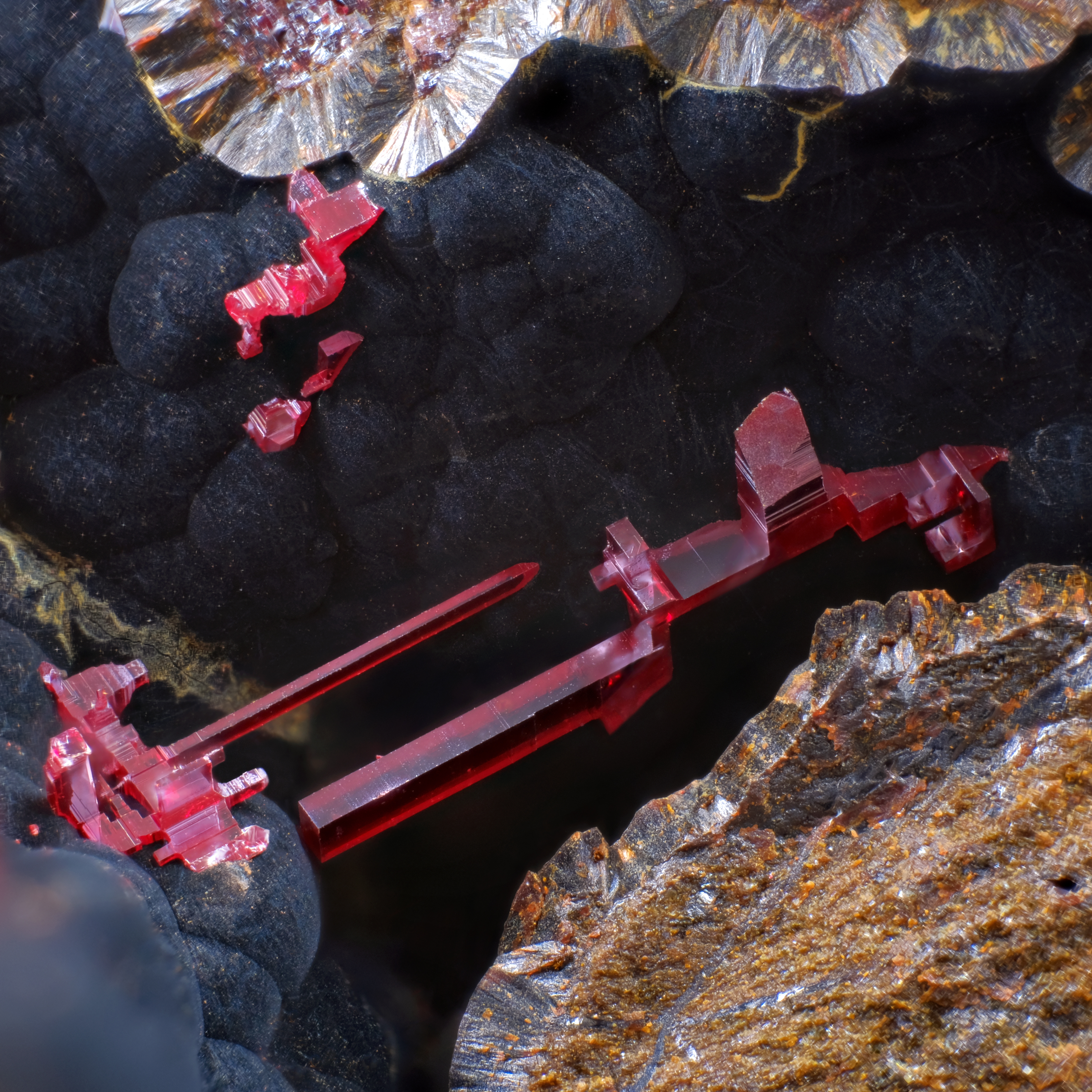Cuprite Gemstone: Properties, Meanings, Value & More
 Cuprite is a red copper mineral found all over the world. Is cuprite a gem? Yep! Cuprite is also used as a gemstone in jewelry and decor.
Cuprite is a red copper mineral found all over the world. Is cuprite a gem? Yep! Cuprite is also used as a gemstone in jewelry and decor.
The stone’s coloring can resemble garnet or ruby and its brilliant sparkle exceeds that of diamond. These qualities make cuprite a necessary addition to any collection.
Gem-quality cuprite is also very rare, making it even more desirable for collectors or enthusiasts.
Interested in browsing some cuprite gemstones for sale? This guide will tell you everything you need to know about cuprite, from its properties and prices to healing powers and history.
 Image credit: Rob Lavinsky, iRocks.com – CC-BY-SA-3.0
Image credit: Rob Lavinsky, iRocks.com – CC-BY-SA-3.0
What Is A Cuprite Stone?
Cuprite is a semi-precious gemstone, despite sharing the coloring of ruby and sparkle of diamond, two of the four precious gemstones (with sapphire and emerald). One nickname for cuprite, in fact, is “ruby copper” or “ruby copper ore.”
As a more affordable alternative to ruby, cuprite can be substituted as a July birthstone. Cuprite can also be an alternate January birthstone for its resemblance to garnet. It can also substitute the traditional 2nd wedding anniversary gemstone (garnet) or 40th anniversary gem (ruby).
Astrologically, cuprite is a zodiac stone for the earth signs — Taurus, Virgo, and Capricorn. It also resonates with the number 2 in numerology.
Outside of gemstones, what is cuprite used for?
Though once a source of copper, the most significant cuprite uses have been for dyeing or coloring purposes to create red glass.
Cuprite Specifications & Characteristics
First, is cuprite a copper? In the sense that it’s a copper mineral, yes, but it isn’t solely copper. Rather, it’s a copper oxide. The cuprite formula is Cu2O.
After cuprite forms, it may pseudomorph (alter into a new mineral but with the same crystal shape) into malachite. Malachite is a green copper carbonate hydroxide with the formula Cu2CO3(OH)2.
One key identification method is a streak test. With a raw specimen and a streak plate, you can firmly scrape an inconspicuous area of the stone to see what color powder it produces (its streak). A true cuprite streak will be a metallic brownish-red.
Cuprite also ranks very low on the Mohs mineral hardness scale, meaning most minerals will scratch it. Being metallic, it’s also dense, so it’ll feel heavier than other stones with the same dimensions.
The form cuprite takes may be octahedral, cubic, or dodecahedral, though the latter is the rarest. Penetration twinning is also common, where a crystal grows and diverges in two different directions, creating a “twin” crystal. The mineral shape varies, however, which we’ll cover more next.
For now, here are the remaining mineral properties of cuprite:
Mohs hardness: 3.5-4
Color: Red, dark red, black
Crystal structure: Isometric/Cubic
Luster: Sub-metallic, adamantine, earthy
Transparency: Transparent to opaque
Refractive index: 2.84-2.85
Density: 6.14-6.15; 6.00-6.07 (Namibian material)
Cleavage: Poor, 4-directions
Fracture: Conchoidal
Streak: Metallic brownish-red
Luminescence: None
Pleochroism: Present anomalously (because crystal lacks birefringence)
A few of the crystal habits of cuprite constitute different varieties of the stone.
Types of Cuprite
Some cuprite mixtures or variants (too similar to be considered varieties, but distinct enough to warrant separate names) are:
Burnite: Rock composed of cuprite, azurite, and sometimes malachite
Tile Ore: Cuprite variant with massive habit and brick red coloring, often found beside malachite
Chalcotrichite: Also called “plush copper ore,” a cuprite variant with thin, fibrous crystal mats or sprays resembling hairs
Chalcotrichite is perhaps the most well-known variant. The name comes from the German chalkotrichit, derived from Greek terms for “copper” and “hair.”
You may see the matted growths on top of calcite crystals.
 Image credit: Rob Lavinsky, iRocks.com – CC-BY-SA-3.0
Image credit: Rob Lavinsky, iRocks.com – CC-BY-SA-3.0
Cuprite Meaning & History
Cuprite symbolizes fundamental needs, nourishment, and reassurance. The cuprite spiritual meaning has also been interpreted to represent strength, vigor, and motivation.
Within metaphysical practices, cuprite belongs to the earth element. Different interpretations take this to mean cuprite is associated with Mother Earth and shamanism. In the ancient energy balancing art of Feng Shui, earth stones tie to security, intellect, and family.
History
The name “cuprite” derives from the Latin cuprum, meaning “copper.” Austrian mineralogist Wilhelm Karl Ritter von Haidinger (or simply Wilhelm Haidinger) chose the name in 1845.
Before Haidinger chose the name that stuck, former names for cuprite included:
Ruberite
Octahedral Copper / Octahedral Copper Ore
Red Copper / Red Glassy Copper Ore
Oxydulated Copper
Hydrocuprite
Uses for cuprite go back thousands of years. Archeological records show that cuprite has been used to give glass a red color, creating the product called ruby glass, since the 2,000 to 1,000 BC.
Shifting to the modern era, cuprite has become exceedingly rare. The best gem-quality specimens came from Namibia in the 1970s.
 Image credit: Masha Milshina | Creative Commons Attribution 4.0 International license
Image credit: Masha Milshina | Creative Commons Attribution 4.0 International license
Cuprite Healing Properties
The color and energies within a gemstone can influence its ability as a healing stone. Cuprite gemstones are red, evoking benefits of red gemstones like boosting motivation, energy, and passion.
The majority of cuprite isn’t gem-quality and may possess a blackish hue. Like other black gemstones, these crystals offer greater commitment to spiritual practice, higher knowledge, and protection from malevolent forces.
But what about the physical, emotional, and chakra healing properties of cuprite?
Physical Healing
Some purported benefits of cuprite include treating:
Kidney dysfunction
Bladder problems
Vertigo
Motion sickness
Reproductive issues
Oxidative stress
Like its spiritual meaning and associations, cuprite’s physical properties revolve around increasing physical energy and stamina. The stone is believed to promote longevity and physical health overall.
Emotional Healing
On the emotional side, cuprite is said to do wonders for the brain. It’s believed to make you more analytical, intelligent, and creative.
The cuprite crystal can also dispel melancholy, bring calm during emotional hardship, and help you overcome irrational anxieties by nourishing your spirit with feelings of support and safety.
Chakra Healing
Balancing chakras is an ancient art of identifying negative symptoms, figuring out which chakra (energy center) the symptoms are tied to, and opening the chakra to resolve the symptoms.
Cuprite is a chakra stone for the root (or base) chakra, which governs fundamental needs like security, grounding, and connection. When it’s blocked, you sense danger at all times or may even feel yourself drifting from reality. Using cuprite, you can open the chakra to ground yourself and feel connected to family or loved ones.
On the gemstone side of things, how does cuprite get graded?
 Pictured above: Azurite cabochon with red cuprite inclusions
Pictured above: Azurite cabochon with red cuprite inclusions
Cuprite Gemstone Properties
Cuprite’s value depends on where each individual stone falls based on the categories of color, cut, and size.
Color
The best color is unarguably the signature cuprite ruby red hue. Not only is this tone beautiful, it’s also rare to find gem-quality cuprites with this coloring.
The cause of cuprite’s color is in its copper composition — the same cause behind the color of azurite and malachite.
However, cuprite can also be different shades of red and even near black. These hues are less valuable.
Cut
Cutting cuprite into faceted shapes is best for bringing out its lush coloring, high refractive index, metallic luster, and stunning brilliance. A well-cut cuprite will be highly valuable. That said, a poorly executed faceted cut will often mean a dull, dark-colored stone with lower value.
Unfortunately, cuprite’s softness makes jewelry use inadvisable for faceted options. However, beads and cabochons are still gorgeous cuprite jewelry options!
Most often, you’ll see cuprite for sale when it’s mixed as an inclusion in other stones, cuprite azurite or cuprite chrysocolla. Less often, these other stones are found as inclusions in cuprite.
Size
Part of cuprite’s rarity derives from the fact that the majority of its crystals are simply too tiny for gems. However, one Namibian deposit (in Onganja) has produced gem-quality crystals large enough for faceting, making cuprite from these sources valuable.
Speaking of its sources, how does cuprite form? And where does it come from?
 Image credit: Masha Milshina | Creative Commons Attribution 4.0 International license
Image credit: Masha Milshina | Creative Commons Attribution 4.0 International license
Cuprite Formation & Sources
Cuprite typically forms when copper deposits undergo weathering. Groundwater reacts with copper minerals in the deposit, the primary minerals, causing them to alter into secondary minerals. One of these secondary minerals is cuprite.
You’ll typically find cuprite in oxidized areas of copper-rich lodes (veins between rocks). It’s usually beside native copper, azurite, malachite, and limonite.
Mining Locations
Where is cuprite stone found? The largest gem-quality culprite crystals come from Namibia. Additional sources of cuprite include:
Africa
Australia
Bolivia
Chile
England
France
Japan
Mongolia (Altai Mountains)
Russia (Ural Mountains)
Sardinia
USA (Arizona)
Of course, the most important question to most buyers is: how much does a cuprite stone cost?

Cuprite Stone Price & Value
The cuprite price for faceted gemstones is $40-$200 per carat.
Most cabochons are azurite cuprite, malachite cuprite, or chrysocolla cuprite. These stones go for around $50 to $200 each at wholesale. Chrysocolla and cuprite mixtures are sometimes sold as “Sonora Sunrise” or “Sonora Sunset.”
Cuprite rough has more broad pricing, starting around $5 to $10 and reaching upwards of $200.
Cuprite Care and Maintenance
Before we discuss gemstone care, let’s first discuss taking care of your own health. Given its copper content, you may wonder: is cuprite toxic? It can be. Cuprite dust or fibers are dangerous to inhale, potentially causing vomiting and even kidney or liver damage with repeated exposure.
However, cuprite dust is mainly a concern for gemstone cutters or anyone handling rough specimens. Polished specimens are safe to handle.
Onto gemstone care, the first step is choosing the right cuprite. Its softness makes it vulnerable, so we recommend opting for less vulnerable pendants or earrings rather than a cuprite ring.
Regardless of which you choose, opt for jewelry with protective settings to ensure the best protection from scratches or breakage.
You can clean polished or faceted cuprite with mild soap and lukewarm water. Once you’ve rinsed any excess soap residue, use a soft, dust-free, microfiber cloth to dry the stone. Don’t use harsh household cleaning products, chemicals, or mechanical/ultrasonic cleaners.
It’s best to store cuprite stones and jewelry in a dark, enclosed space away from other gemstones.
Cultivate Your Collection with a Cuprite Stone!
Gem collectors may know more about cuprite than the average buyer, but that makes the stone more elusive and fascinating. Its sparkling brilliance combined with a metallic luster and magical red hues are perfect for keeping your spirit, and spiritedness, vibrant and alive!
Was this article helpful?
Ross Sedawie
- Written - 14th Aug 2022
- Edited - 1st Aug 2023
















